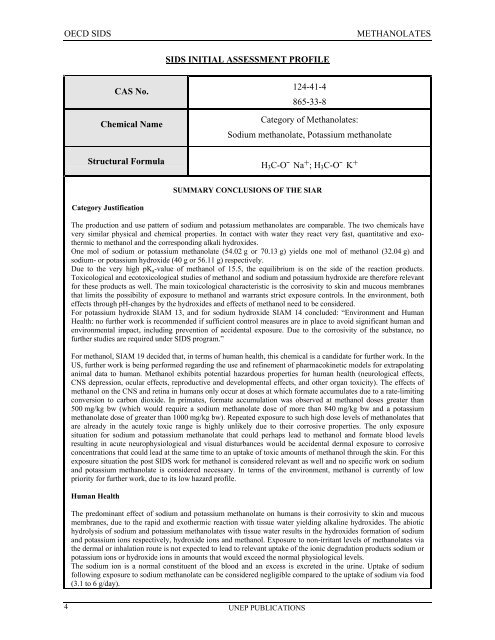Sodium methanolate - ipcs inchem
Sodium methanolate - ipcs inchem
Sodium methanolate - ipcs inchem
Create successful ePaper yourself
Turn your PDF publications into a flip-book with our unique Google optimized e-Paper software.
OECD SIDS<br />
METHANOLATES<br />
SIDS INITIAL ASSESSMENT PROFILE<br />
CAS No.<br />
Chemical Name<br />
124-41-4<br />
865-33-8<br />
Category of Methanolates:<br />
<strong>Sodium</strong> <strong>methanolate</strong>, Potassium <strong>methanolate</strong><br />
Structural Formula<br />
H 3 C-O¯ Na+; H 3 C-O¯ K+<br />
SUMMARY CONCLUSIONS OF THE SIAR<br />
Category Justification<br />
The production and use pattern of sodium and potassium <strong>methanolate</strong>s are comparable. The two chemicals have<br />
very similar physical and chemical properties. In contact with water they react very fast, quantitative and exothermic<br />
to methanol and the corresponding alkali hydroxides.<br />
One mol of sodium or potassium <strong>methanolate</strong> (54.02 g or 70.13 g) yields one mol of methanol (32.04 g) and<br />
sodium- or potassium hydroxide (40 g or 56.11 g) respectively.<br />
Due to the very high pK a -value of methanol of 15.5, the equilibrium is on the side of the reaction products.<br />
Toxicological and ecotoxicological studies of methanol and sodium and potassium hydroxide are therefore relevant<br />
for these products as well. The main toxicological characteristic is the corrosivity to skin and mucous membranes<br />
that limits the possibility of exposure to methanol and warrants strict exposure controls. In the environment, both<br />
effects through pH-changes by the hydroxides and effects of methanol need to be considered.<br />
For potassium hydroxide SIAM 13, and for sodium hydroxide SIAM 14 concluded: “Environment and Human<br />
Health: no further work is recommended if sufficient control measures are in place to avoid significant human and<br />
environmental impact, including prevention of accidental exposure. Due to the corrosivity of the substance, no<br />
further studies are required under SIDS program.”<br />
For methanol, SIAM 19 decided that, in terms of human health, this chemical is a candidate for further work. In the<br />
US, further work is being performed regarding the use and refinement of pharmacokinetic models for extrapolating<br />
animal data to human. Methanol exhibits potential hazardous properties for human health (neurological effects,<br />
CNS depression, ocular effects, reproductive and developmental effects, and other organ toxicity). The effects of<br />
methanol on the CNS and retina in humans only occur at doses at which formate accumulates due to a rate-limiting<br />
conversion to carbon dioxide. In primates, formate accumulation was observed at methanol doses greater than<br />
500 mg/kg bw (which would require a sodium <strong>methanolate</strong> dose of more than 840 mg/kg bw and a potassium<br />
<strong>methanolate</strong> dose of greater than 1000 mg/kg bw). Repeated exposure to such high dose levels of <strong>methanolate</strong>s that<br />
are already in the acutely toxic range is highly unlikely due to their corrosive properties. The only exposure<br />
situation for sodium and potassium <strong>methanolate</strong> that could perhaps lead to methanol and formate blood levels<br />
resulting in acute neurophysiological and visual disturbances would be accidental dermal exposure to corrosive<br />
concentrations that could lead at the same time to an uptake of toxic amounts of methanol through the skin. For this<br />
exposure situation the post SIDS work for methanol is considered relevant as well and no specific work on sodium<br />
and potassium <strong>methanolate</strong> is considered necessary. In terms of the environment, methanol is currently of low<br />
priority for further work, due to its low hazard profile.<br />
Human Health<br />
The predominant effect of sodium and potassium <strong>methanolate</strong> on humans is their corrosivity to skin and mucous<br />
membranes, due to the rapid and exothermic reaction with tissue water yielding alkaline hydroxides. The abiotic<br />
hydrolysis of sodium and potassium <strong>methanolate</strong>s with tissue water results in the hydroxides formation of sodium<br />
and potassium ions respectively, hydroxide ions and methanol. Exposure to non-irritant levels of <strong>methanolate</strong>s via<br />
the dermal or inhalation route is not expected to lead to relevant uptake of the ionic degradation products sodium or<br />
potassium ions or hydroxide ions in amounts that would exceed the normal physiological levels.<br />
The sodium ion is a normal constituent of the blood and an excess is excreted in the urine. Uptake of sodium<br />
following exposure to sodium <strong>methanolate</strong> can be considered negligible compared to the uptake of sodium via food<br />
(3.1 to 6 g/day).<br />
4<br />
UNEP PUBLICATIONS
















